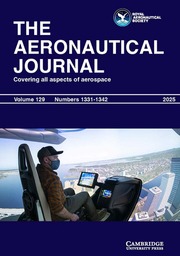No CrossRef data available.
Article contents
Design and experimental study of a helicopter seat cushion for vibration isolation
Published online by Cambridge University Press: 26 August 2025
Abstract
Vibration is defined as oscillation away from equilibrium and is a significant problem in aviation. Vibration is transmitted to the flight crew through all contact surfaces, including flight controls, floor and seats. Various effects are known to occur on flight crew exposed to vibration, with fatigue and low back pain being the most common vibration-related health complaints. Studies have shown that prolonged exposure to vibration or accumulated vibration can increase the risk of chronic low back pain and injury by increasing the exposure dose. In particular, there is data that helicopter pilots have more low back pain than fixed wing pilots. This is due to the fact that helicopters have much more vibration-generating factors due to the working principle of helicopters and the posture of helicopter pilots is slightly forward-leaning. In this study, an isolator cushion with a quasi-zero stiffness mechanism was developed, manufactured and tested to reduce the transmission of vibration to the pilot and flight crew during the operation of the Sikorsky UH-60 helicopter. The use of the specially designed cushion led to a noticeable reduction in vibration exposure under various flight conditions.
Keywords
Information
- Type
- Research Article
- Information
- Copyright
- © The Author(s), 2025. Published by Cambridge University Press on behalf of Royal Aeronautical Society


